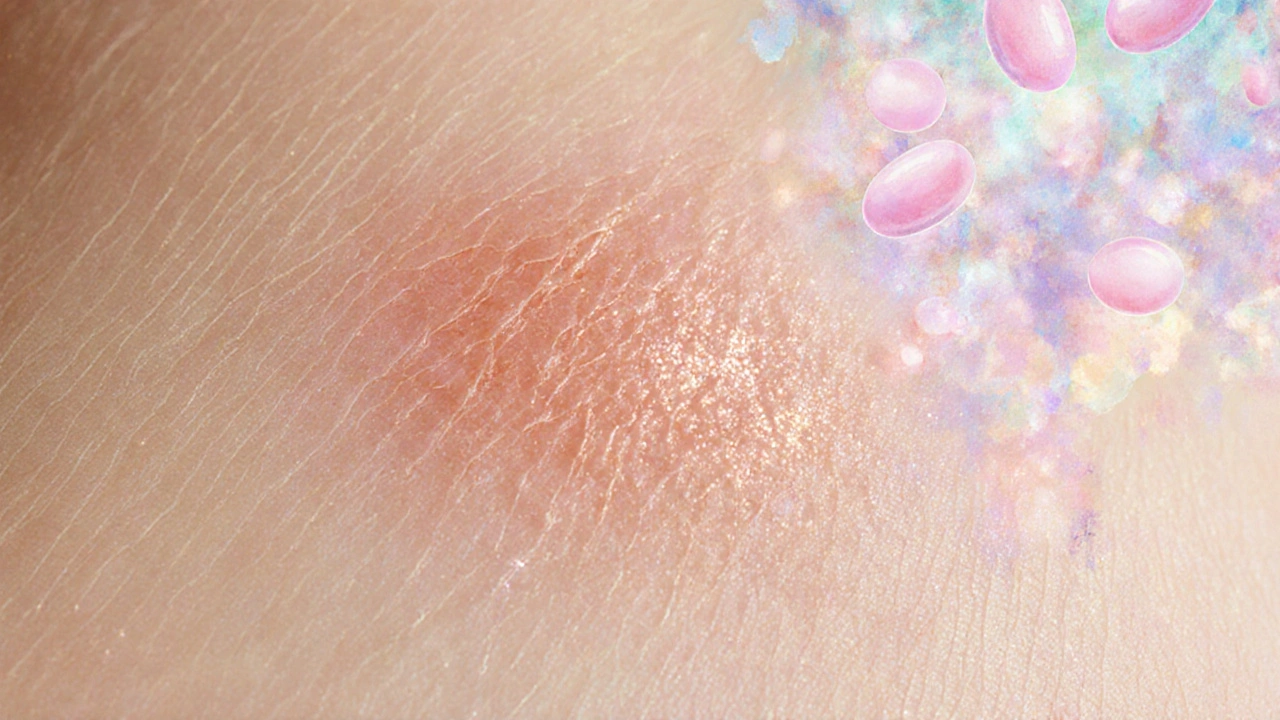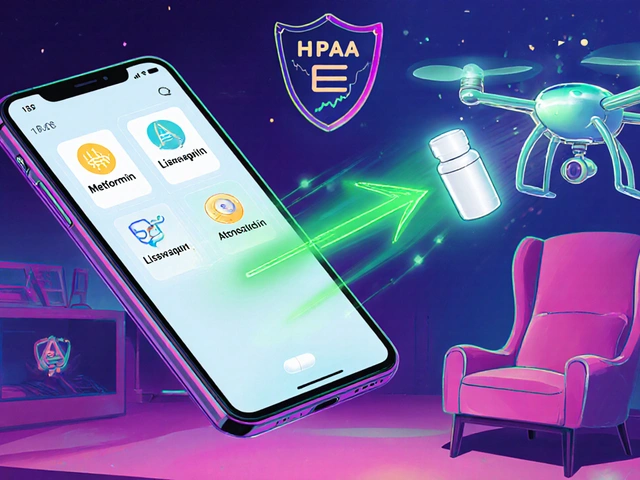
Quick Take
- PRP uses your own blood to deliver a high dose of growth‑stimulating platelets.
- It boosts collagen production, softens scar texture, and reduces redness.
- Unlike laser or silicone sheets, PRP is minimally invasive and has a short recovery.
- Best for acne scars, surgical marks, and stretch‑mark‑like tissue.
- Side‑effects are usually limited to mild swelling and bruising.
When it comes to smoothing out stubborn scars, platelet-rich plasma therapy is a minimally‑invasive treatment that uses a concentration of your own platelets to jump‑start the body’s natural healing processes. The idea sounds high‑tech, but the science behind it is surprisingly simple: draw a small amount of blood, spin it in a centrifuge, and inject the platelet‑rich layer straight into the scar. What follows is a cascade of cellular activity that can reshape scar tissue from the inside out.
What Exactly Is PRP?
Platelets are the tiny blood cells that clot wounds. Inside each platelet lives a vault of growth factors-proteins such as PDGF, TGF‑β, and VEGF-that signal the body to repair damage. By concentrating platelets, PRP delivers a super‑charged dose of these messengers directly where they’re needed.
The term “autologous” means the blood comes from you, not a donor, which eliminates the risk of allergic reaction or disease transmission. In a typical session, 10‑15ml of blood yields enough PRP for several injection sites, making the whole process quick and cost‑effective.
How PRP Works on Scar Tissue
Scars form when the body lays down excess collagen in a rushed attempt to close a wound. Over time, this collagen can become dense, disorganized, and pigmented, creating the raised or red patches we see on skin.
When PRP is injected, its growth factors perform three key actions:
- Activate fibroblasts-the fibroblasts are the cells that manufacture collagen. PRP tells them to produce new, more orderly collagen fibers rather than the haphazard bundles typical of scar tissue.
- Increase collagen turnover, which softens the scar and improves elasticity.
- Boost blood flow via VEGF, bringing oxygen and nutrients that further accelerate tissue remodeling.
Clinical studies published between 2018 and 2024 report an average scar thickness reduction of 28% and a noticeable fade in discoloration after three to four PRP sessions. The results are especially pronounced for acne‑related scars, where inflammation is a major driver.
Benefits Over Traditional Scar Treatments
Many people first try silicone gel sheets, corticosteroid injections, or laser resurfacing. While each method has its place, PRP offers several distinct advantages:
- Natural material: Because the plasma comes from your own body, there’s no foreign substance introduced.
- Multi‑layer impact: PRP works at the cellular level, not just the surface, leading to longer‑lasting improvements.
- Minimal downtime: Most patients resume normal activities within 24hours.
- Versatility: It can be combined with microneedling or laser to enhance results.
Who Can Benefit?
Ideal candidates include:
- People with mild to moderate atrophic or hypertrophic acne scars.
- Patients recovering from surgical incisions who want a flatter, less noticeable line.
- Individuals with stretch‑mark‑like tissue after rapid weight changes.
Those with active infections, blood‑clotting disorders, or who are currently on anticoagulant therapy should avoid PRP until cleared by a physician. Pregnant or nursing mothers are also advised to postpone treatment.

What to Expect During a Session
The procedure typically follows these steps:
- Cleaning the treatment area and applying a local anesthetic.
- Drawing 10‑15ml of blood from the arm.
- Spinning the sample in a centrifuge for 5‑10minutes to isolate the platelet layer.
- Injecting the concentrated PRP into the scar using a fine‑gauge needle.
- Applying a light compression dressing and providing after‑care instructions.
Each session lasts about 30minutes. Most clinicians recommend 3‑4 sessions spaced 4‑6weeks apart for optimal remodeling.
Potential Side‑Effects and Contra‑Indications
Because PRP uses your own blood, serious complications are rare. The most common reactions are:
- Transient redness or swelling at the injection sites.
- Minor bruising that fades within a few days.
- Temporary tenderness that resolves within a week.
If you experience increasing pain, fever, or prolonged swelling, contact your provider-these could signal an infection.
How PRP Stacks Up Against Other Options
| Feature | PRP Therapy | Silicone Gel/Sheets | Corticosteroid Injection | Laser Resurfacing |
|---|---|---|---|---|
| Material | Autologous blood | Synthetic polymer | Steroid medication | Light‑based energy |
| Mechanism | Stimulates cellular repair | Moisture barrier | Reduces inflammation | Ablates epidermis |
| Downtime | ~1day | None | 2‑3days | 1‑2weeks |
| Typical Cost (US) | $300‑$600 per session | $30‑$100 total | $150‑$300 per injection | $800‑$2000 per treatment |
| Results Timeline | 4‑12weeks | 3‑6months | 2‑4weeks | Immediately, with gradual fade |
For many, the combination of natural material and short recovery makes PRP the most appealing first‑line option, especially when the scar is still relatively fresh.
Looking Ahead: Emerging Research
Researchers are exploring PRP in conjunction with stem‑cell therapy and hyaluronic‑acid microneedling to push scar remodeling even further. Early pilot studies suggest a synergistic effect, but larger trials are needed before these combos become standard practice.
Frequently Asked Questions
Is PRP safe for all skin types?
Yes, because the treatment uses your own blood, skin color does not affect safety. However, people with a tendency toward excessive scar formation (keloids) should discuss risks with a dermatologist.
How many sessions will I need?
Most clinicians recommend 3‑4 sessions spaced 4‑6 weeks apart. Some patients notice improvement after the first session, while others achieve the best results after the full series.
Can PRP be combined with other scar treatments?
Absolutely. PRP is often used after microneedling or laser resurfacing to boost healing and reduce downtime. Your provider can design a protocol that fits your scar type.
What should I do after a PRP session?
Keep the treated area clean, avoid direct sunlight for 48hours, and skip heavy exercise for a day. Applying a light moisturizer can help with mild dryness.
Is PRP covered by insurance?
Most plans consider PRP cosmetic, so coverage is rare. Check with your insurer and ask the clinic about payment plans.
Whether you’re battling stubborn acne marks or want a smoother surgical line, platelet‑rich plasma therapy offers a science‑backed path to softer, less noticeable scars. Talk to a board‑certified dermatologist or plastic surgeon to see if this natural, low‑downtime option fits your skin goals.
Ada Lusardi
I was literally wowed by the idea of using my own blood to heal scars 😊
It feels like a superhero serum tailored just for me.
The minimal downtime is a huge plus, especially when you have a busy schedule.
Just think, a simple draw and spin, then boom-collagen boost!
Can't wait to try it and see the scar fade away.
Pam Mickelson
The explanation of platelet function is spot‑on and grammatically immaculate.
Growth factors such as PDGF and TGF‑β are clearly described, which helps readers understand the biology without getting lost.
I also appreciate the concise breakdown of the procedure steps.
Overall, a well‑structured overview that balances detail with readability.
Joe V
Ah, another “miracle” treatment that promises miracles-how original.
While the science is not entirely bogus, the hype surrounding PRP often eclipses the modest gains seen in controlled trials.
One must remember that “natural” does not automatically equal “superior.”
In the end, it’s a pricey add‑on that may work for some, but it’s far from a universal solution.
Scott Davis
PRP sounds like the hype train, but it works.
Alan Whittaker
Do you ever wonder why big pharma pushes laser and silicone sheets so hard?
It’s as if they’re scared of a treatment that uses nothing but your own blood.
PRP sidesteps the drug pipeline, reducing the need for proprietary creams and devices.
Some call it a conspiracy; I call it a market disruption waiting to happen.
Michael Waddington
Look, the data is decent, but the marketing is overblown.
People think they’re getting a sci‑fi miracle, yet it’s basically a concentrated platelet injection.
If you’re after a quick fix, you’re better off with proven laser protocols.
PRP can be a useful adjunct, but don’t treat it like a magic bullet.
rahul s
Nothing beats the power of our own blood, innit?
Why outsource healing to foreign chemicals when your veins hold the secret?
PRP is the ultimate home‑grown solution for scar warriors.
Give it a go and flaunt that proud, home‑grown recovery!
Julie Sook-Man Chan
I’ve tried PRP for a few acne scars and noticed a subtle softening after the second session.
The downtime was truly minimal, just a day of mild swelling.
If you’re patient and follow post‑care instructions, it can be a gentle addition to your routine.
Amanda Mooney
For anyone on the fence, consider that PRP harnesses your body’s own repair mechanisms.
When combined with proper skincare, the results can be surprisingly encouraging.
Stay consistent with the recommended sessions, and you’ll likely see a gradual but meaningful improvement.
Mandie Scrivens
Sure, PRP is “natural,” but natural doesn’t mean flawless.
It’s still a procedure that can cause bruising and requires multiple visits.
Don’t expect a miracle after a single injection.
Natasha Beynon
PRP can be a compassionate option for those who prefer autologous treatments.
Its low side‑effect profile makes it appealing for sensitive skin types.
Just remember to discuss any blood‑thinning medications with your physician beforehand.
Alex Feseto
From an academic standpoint, the mechanistic rationale behind platelet‑rich plasma is commendable.
By delivering a concentrated milieu of growth factors, one theoretically facilitates dermal remodeling at a cellular level.
Nonetheless, the heterogeneity of preparation protocols across practices complicates the extrapolation of uniform efficacy.
Future investigations should standardize centrifugation parameters to enable robust meta‑analyses.
vedant menghare
The integration of PRP into modern dermatologic practice reflects a broader trend toward biologically driven therapies.
Initially, the concept of autologous platelet concentration appeared simplistic, yet subsequent research elucidated its intricate cascade of cytokines and growth factors.
When administered into scar tissue, these bioactive molecules stimulate fibroblast activity, promoting the synthesis of organized collagen bundles.
Moreover, the angiogenic properties conferred by VEGF enhance perfusion, delivering essential nutrients for tissue regeneration.
Clinical trials between 2018 and 2024 consistently reported a measurable reduction in scar thickness, often hovering around twenty‑plus percent.
Subjective patient satisfaction scores also improved, underscoring the psychosocial benefit of diminished scar visibility.
Importantly, the procedure’s minimally invasive nature translates to a swift return to daily activities, a factor that resonates with today’s time‑constrained populace.
While side‑effects remain limited to transient erythema and bruising, practitioners must remain vigilant for atypical inflammatory responses.
Contra‑indications such as coagulopathies or active infections are well‑documented and must be screened pre‑procedurally.
In terms of cost‑effectiveness, the per‑session expense is moderate, especially when juxtaposed against the capital outlay required for laser systems.
Economically, PRP may democratize access to advanced scar management in resource‑limited settings.
Future avenues, including synergistic combinations with mesenchymal stem cells or hyaluronic acid microneedling, promise to amplify remodeling outcomes.
Nevertheless, rigorous, large‑scale randomized controlled trials are requisite to substantiate these preliminary findings.
In conclusion, PRP stands as a compelling, evidence‑backed modality that bridges the gap between natural healing and aesthetic enhancement.
Kevin Cahuana
Great summary! I’d add that patient selection is key-those with keloid tendencies should proceed with caution.
Also, documenting baseline scar measurements helps quantify improvement over the treatment course.
Danielle Ryan
Whoa, hold up! Do you really think it’s safe to just spin blood and stick it everywhere?!!
What about hidden infections, silent clotting disorders-these aren’t "just a little bruise"!!
People need to be warned before they jump on the hype train!!!
Robyn Chowdhury
While the enthusiasm is palpable, let’s not overlook the nuanced risk profile.
Even with autologous sources, procedural sterility and patient history remain paramount. 🤔
Deb Kovach
For anyone considering PRP, I recommend a pre‑procedure consultation to review your medical history, discuss expectations, and ensure proper after‑care.
Feel free to DM me for detailed guidelines or reputable clinics.
Sarah Pearce
Interesting....





Write a comment